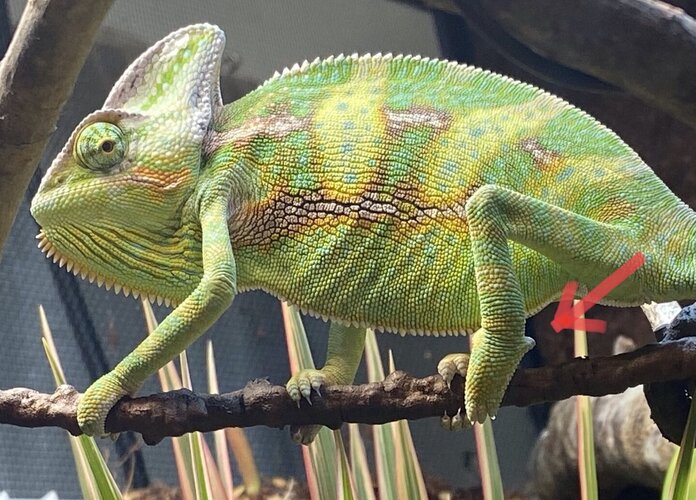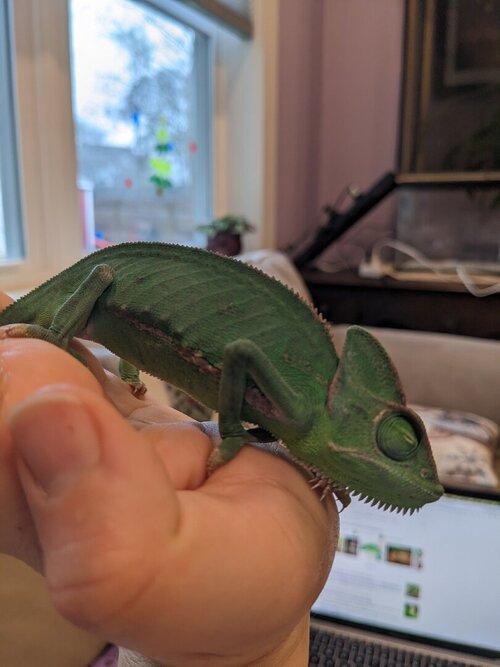Moxie79
New Member
Hello,
I've read an older post about pet sitting, I want to be sure I'm clear on a few things, after doing some research here and other sites.
The chameleon was delivered to us with a mesh enclosure built on top of a glass terrarium. It previously had live plants, but I guess they died and the owners wanted it to be easy for us, so they just replaced with plastic plants. I added a thick dowel at a good spot from the basking lamp, as well. Cammy was delivered with a dripper and with a small water fountain, a red bulb and white bulb (I was told to run white during the day and red at night), and a bunch of crickets and mealworms. Cammy has eaten crickets but not many mealworms.
My questions are:
1) how did this family start hosting Cammy without knowing he needs UVB? I want to go buy him a proper UVB lamp and charge them for it. (Just today I purchased thermo- and hygro-meters for the top and bottom of the enclosure, I'll be asking them to reimburse for that too).
2) is it ok to just feed Cammy crickets, since that's all he seems to eat? Should I try a different worm?
3) I read here that the water fountain is a bad idea- I should take that out and set up the dripper to run better? (I've used the dripper off and on, since I knew Cammy has the fountain too.)
4) There is no substrate at the bottom, which I read is good (hooray!) But they did put paper towels down, which I've been changing a couple times since. Is that ok? Should I just remove the paper towel? Before reading about substrate concerns I picked up some moss to put down there, but I haven't yet, should I just not?
5) I was given no instructions on how to properly handle Cammy (nor told that chameleons don't really like to be held!) I picked him up once or twice as I would a mammal, very gently but around the middle, to clean his cage and whatnot, and just yesterday I noticed that maybe his ribs are a little.... Not right. I honestly don't know if he came to me that way, or if I'm responsible. Is there anything I can do about this? I'm so sad.
I want to do the best I can to take care of this little guy/girl. I don't even know what species he is! I think veiled?

I can't wait to share this wonderful resource with my friends, I'm sure they'll learn a lot from it.
I've read an older post about pet sitting, I want to be sure I'm clear on a few things, after doing some research here and other sites.
The chameleon was delivered to us with a mesh enclosure built on top of a glass terrarium. It previously had live plants, but I guess they died and the owners wanted it to be easy for us, so they just replaced with plastic plants. I added a thick dowel at a good spot from the basking lamp, as well. Cammy was delivered with a dripper and with a small water fountain, a red bulb and white bulb (I was told to run white during the day and red at night), and a bunch of crickets and mealworms. Cammy has eaten crickets but not many mealworms.
My questions are:
1) how did this family start hosting Cammy without knowing he needs UVB? I want to go buy him a proper UVB lamp and charge them for it. (Just today I purchased thermo- and hygro-meters for the top and bottom of the enclosure, I'll be asking them to reimburse for that too).
2) is it ok to just feed Cammy crickets, since that's all he seems to eat? Should I try a different worm?
3) I read here that the water fountain is a bad idea- I should take that out and set up the dripper to run better? (I've used the dripper off and on, since I knew Cammy has the fountain too.)
4) There is no substrate at the bottom, which I read is good (hooray!) But they did put paper towels down, which I've been changing a couple times since. Is that ok? Should I just remove the paper towel? Before reading about substrate concerns I picked up some moss to put down there, but I haven't yet, should I just not?
5) I was given no instructions on how to properly handle Cammy (nor told that chameleons don't really like to be held!) I picked him up once or twice as I would a mammal, very gently but around the middle, to clean his cage and whatnot, and just yesterday I noticed that maybe his ribs are a little.... Not right. I honestly don't know if he came to me that way, or if I'm responsible. Is there anything I can do about this? I'm so sad.
I want to do the best I can to take care of this little guy/girl. I don't even know what species he is! I think veiled?
I can't wait to share this wonderful resource with my friends, I'm sure they'll learn a lot from it.








